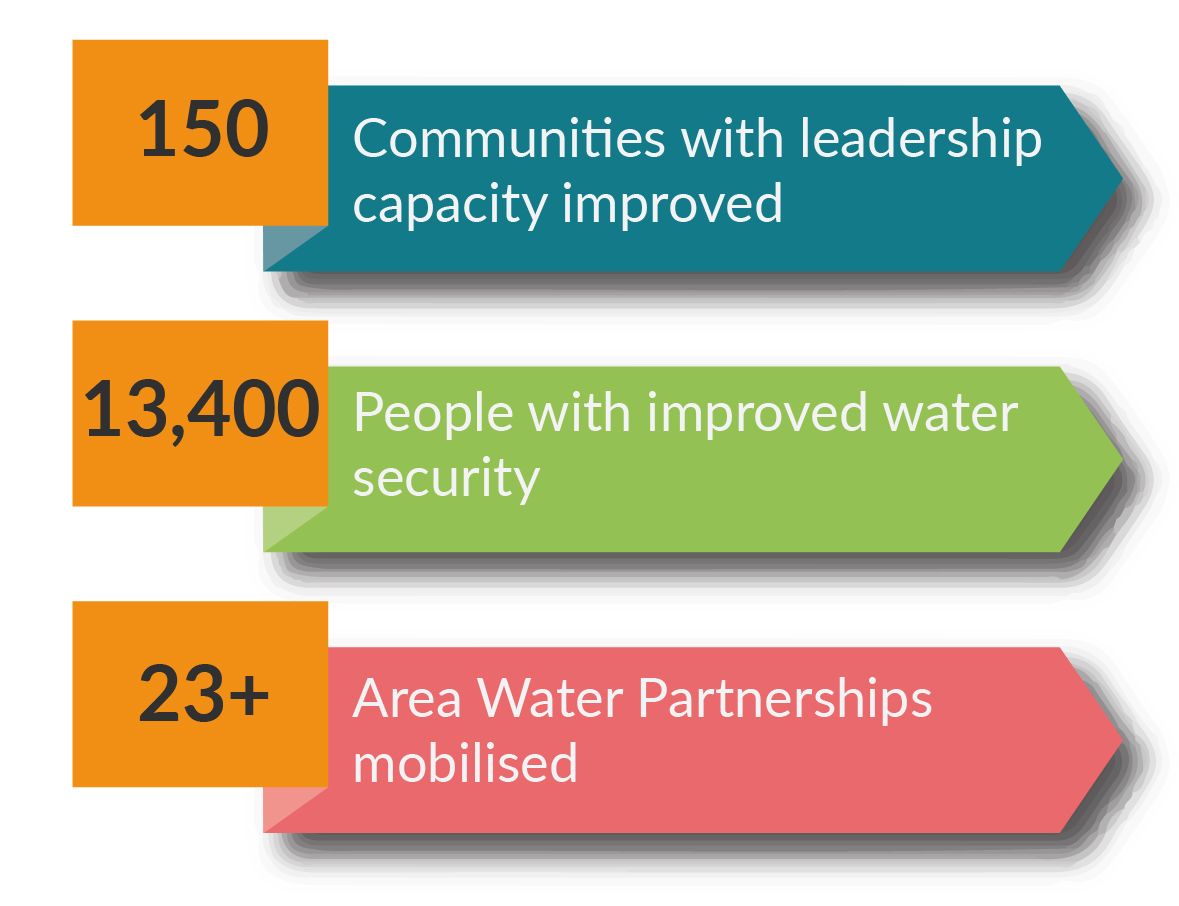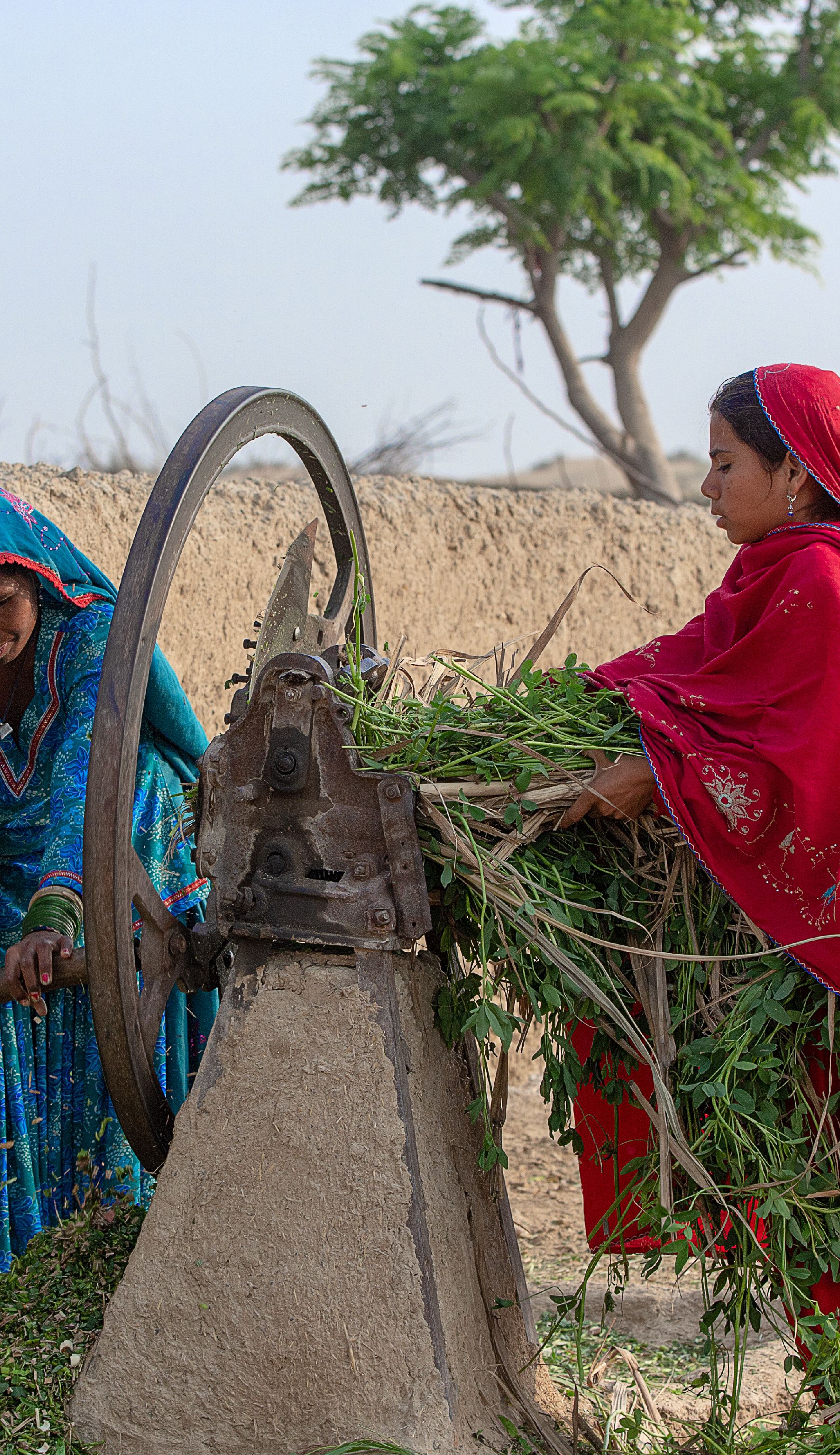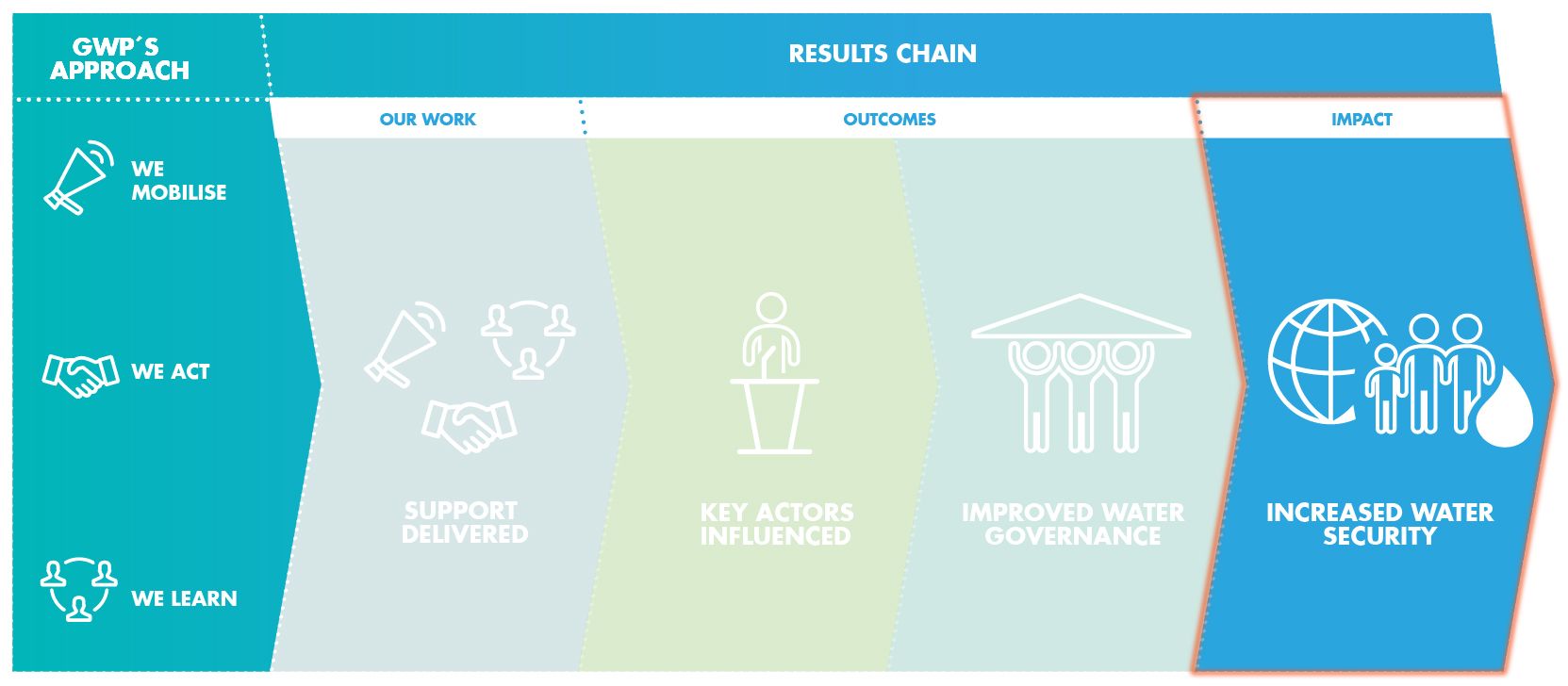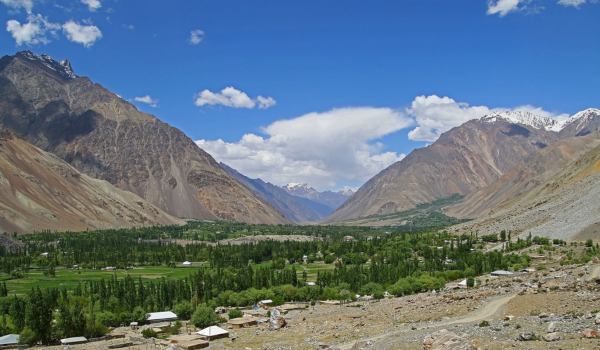A SNAPSHOT | THE CONTEXT | GWP'S CONTRIBUTION | CO-CREATING RESULTS | What is a GWP impact story?
A SNAPSHOT
How to introduce the principles of Integrated Water Resources Management to more than 220 million people, speaking more than 70 different languages and dialects, who live in some of the world’s most remote and climate-challenged regions? From secluded villages in the valleys of the Himalayas to deserts on the border of India, the Pakistan Water Partnership (PWP) is working with communities to gain secure access to water, and the financial resources and technology needed to adapt to a changing climate. Formation of Area Water Partnerships (AWS) across the country has led to new leadership capacity at community level, promoting dialogue and local action. Since their inception, AWS have contributed to improving water security for about 13,400 people in Pakistan.

THE CONTEXT
 In South Asia, both huge cities and remote populations are a challenge to introducing water management approaches that help communities adapt to a changing climate. The region’s river flows, fed by glacier, snowmelt, rainfall, and runoff, are increasingly challenged to provide enough irrigation for crops, and water and sanitation services for growing populations.
In South Asia, both huge cities and remote populations are a challenge to introducing water management approaches that help communities adapt to a changing climate. The region’s river flows, fed by glacier, snowmelt, rainfall, and runoff, are increasingly challenged to provide enough irrigation for crops, and water and sanitation services for growing populations.
The Global Water Partnership South Asia (GWP SAS), recognising that centralised Country Water Partnerships alone could not possibly meet this need, developed the concept of Area Water Partnerships (AWPs): cost-effective local organisations created from a network of local departments, institutions, civil society organisations, and stakeholders that could be set up when there was a common and pressing need in a specific geographic setting, using water as an entry point for natural resources management.
AWPs were set up to allow variety in their membership: the goal was to be able to reach out to other than the usual water players, and to cross sectoral boundaries and work in a partnering mode. Pakistan, with its large population and diverse and challenging landscapes, and mix of institutions with an interest in water, has made good use of this approach.
📢Area Water Partnerships in Pakistan - Muhammad Awais
Pakistan Area Water Partnerships Map
GWP'S CONTRIBUTION
In 2001, the Pakistan Water Partnership (PWP) established its first Area Water Partnership in Sanghar, Sindh province. Since then, 23 more AWPs have provided new knowledge and skills, and developed leadership capacity in more than 150 communities, and improved water security for about 13,400 people across the country.
Empowering women to resolve conflicts in Sanghar
 The Area Water Partnership in Sanghar, Sindh province, was initially set up to solve water management issues related to the Nara Water Canal, an important water supply channel of the Indus River that irrigates more than 1,500,000 acres (600,000 hectares) of farmland. Scarcity of drinking and irrigation water, poor drainage and sanitation, and conflicts between local administration and government line departments were threatening the delicate balance of cooperation that underpinned orderly and sustainable sharing of the resource. Working with its partner NGO, Women Water Network, the PWP organized formation of the Nara Water Canal AWP to promote dialogue and local action among local-level stakeholders on these issues that were affecting their lives and livelihoods. As a result, conflict related to canal water distribution in 44 villages has been resolved, average household income has increased by 20%, and integrated agricultural practices have been adopted by 32% of the farming community. Livestock mortality has decreased – raising income – and introduction of modern fish farming techniques has increased the number of fish farmers. Through gender awareness work and entrepreneurship training, women have been an important part of these successes, resulting in empowerment of councillors at District and Union Council levels, and more participation in Non-Government Organizations and District Committees. Overall, 2500 people benefitted and the work was selected by the national government for replication in other provinces.
The Area Water Partnership in Sanghar, Sindh province, was initially set up to solve water management issues related to the Nara Water Canal, an important water supply channel of the Indus River that irrigates more than 1,500,000 acres (600,000 hectares) of farmland. Scarcity of drinking and irrigation water, poor drainage and sanitation, and conflicts between local administration and government line departments were threatening the delicate balance of cooperation that underpinned orderly and sustainable sharing of the resource. Working with its partner NGO, Women Water Network, the PWP organized formation of the Nara Water Canal AWP to promote dialogue and local action among local-level stakeholders on these issues that were affecting their lives and livelihoods. As a result, conflict related to canal water distribution in 44 villages has been resolved, average household income has increased by 20%, and integrated agricultural practices have been adopted by 32% of the farming community. Livestock mortality has decreased – raising income – and introduction of modern fish farming techniques has increased the number of fish farmers. Through gender awareness work and entrepreneurship training, women have been an important part of these successes, resulting in empowerment of councillors at District and Union Council levels, and more participation in Non-Government Organizations and District Committees. Overall, 2500 people benefitted and the work was selected by the national government for replication in other provinces.
Enabling safe drinking water in Cholistan
In Pakistan’s Cholistan’s desert, where scorching summers and freezing winters challenge the hardiest nomadic cattle herders to find forage and water for their animals, and where distance and harsh conditions limit the willingness of government officials to visit, formation of an Area Water Partnership has provided safe and secure drinking water resources and healthier living for thousands of people. Severe decades-long drought stimulated the PWP to organise the Bahawalpur AWP, and to propose ways of coping with the difficult conditions. In Cholistan, rainwater is collected seasonally in a system of natural and artificial pools – called tobas or kund – as the groundwater is deep, and too salty for drinking. Water in these pools becomes muddy and impure, leading to illness in both people and animals. A priority, then, for the AWP was to consider community adoption of low-cost filters that used local sand to remove most harmful microbes and heavy metals, learning how to make soap for better hygiene, and use of deworming medicines. The AWP demonstrated bio sand water filters in Cholistan’s interior, and trained community members to prepare their own filters. Complementary health work was carried out in three villages, benefitting more than 2,600 individuals. The work of the AWP also brought attention to other issues related to local development such as unclear land rights, water waste, and poor market conditions for livestock products, allowing the PWP to submit recommendations to central government agencies for further, broader, work.
Promoting WASH in Chitral
One of the world’s highest and steepest mountain districts, Chitral in the Khyber Pakhtunkhwa province of Pakistan, contains more than 40 peaks of over 6,000 meters in height, and is cut off from the rest of the country during winter. Although surrounded by ice-capped mountains, communities in the district have been experiencing higher temperatures and reduced water availability and quality, to the point that water-borne diseases have become common. In July 2018, in partnership with local government and the Aga Khan Rural Support Programme, the PWP supported creation of the Chitral AWP to improve access to drinking water and sanitation. The work has a special focus on youth and women: more than 200 community members in villages have been trained in water management, purification, sanitation, and hygiene.
“There is unlimited value in building capacity and engagement at the local level. In 2015, for example, PWP was helping to develop catchment basins in Tharparkar. A contractor had quoted EUR 500 for each basin. When the quote was reviewed by the AWP, local community members quickly organised themselves to do the work at EUR 70 each basin. Not only was EUR 430 saved, but the local workers took ownership and gained the motivation to maintain the basins. Sustainability requires a sense of ownership.”
Muhammad Awais, PWP
Mobilising better water services in Karachi
 Pakistan’s largest city, Karachi, with a population of more than 20 million, is estimated to bethe sixth most water insecure metropolitan area in the world2. Dysfunctional water services, water borne diseases, and water scarcity plague the city and its peri-urban areas3. In response, in 2007, the city became the host of the South Asia region’s first urban AWP. Partnering with the Hisaar Foundation, the PWP supported formation of the Karachi AWP in the northeast of the city, providing seed funding and the model for stakeholder dialogues and workshops that focused on building partnerships and raising awareness of water supply and wastewater problems4. Government, corporations, and local philanthropists provided financing for implementation. The AWP received a mandate to act through Memoranda of Understanding with city-based institutions, including the City District Government of Karachi and the Karachi Water and Sewerage Board (KWSB). It worked with schools in Gulshan-e-Iqbal Town, rehabilitating water and sanitation infrastructure in schools that benefitted over 8000 children and 100 teachers getting access to WASH services5. Since its launch, more than 300 partners have joined the AWP, contributing to dissemination of water conservation guidelines, appointment of trained water inspectors, and formation of a local Women and Water Network (WWN), which in turn set up 13 sub-networks for each of the local Union Councils within Gulshan-e-Iqbal. These provided an institutional link between the Union Council and Town Council level jurisdictions. The success of the Karachi AWP in reaching more than a million people led to establishment of an additional two AWPs in Karachi, including the Farozaan AWP in 2018, set up in partnership with a local environmental NGO to work on the issue of clean drinking water and sanitation in the city’s poorer areas. Work of the Farozaan AWP has also included drought relief to Tharparker District, and interventions to protect against erosion in Karachi’s coastal settlements.
Pakistan’s largest city, Karachi, with a population of more than 20 million, is estimated to bethe sixth most water insecure metropolitan area in the world2. Dysfunctional water services, water borne diseases, and water scarcity plague the city and its peri-urban areas3. In response, in 2007, the city became the host of the South Asia region’s first urban AWP. Partnering with the Hisaar Foundation, the PWP supported formation of the Karachi AWP in the northeast of the city, providing seed funding and the model for stakeholder dialogues and workshops that focused on building partnerships and raising awareness of water supply and wastewater problems4. Government, corporations, and local philanthropists provided financing for implementation. The AWP received a mandate to act through Memoranda of Understanding with city-based institutions, including the City District Government of Karachi and the Karachi Water and Sewerage Board (KWSB). It worked with schools in Gulshan-e-Iqbal Town, rehabilitating water and sanitation infrastructure in schools that benefitted over 8000 children and 100 teachers getting access to WASH services5. Since its launch, more than 300 partners have joined the AWP, contributing to dissemination of water conservation guidelines, appointment of trained water inspectors, and formation of a local Women and Water Network (WWN), which in turn set up 13 sub-networks for each of the local Union Councils within Gulshan-e-Iqbal. These provided an institutional link between the Union Council and Town Council level jurisdictions. The success of the Karachi AWP in reaching more than a million people led to establishment of an additional two AWPs in Karachi, including the Farozaan AWP in 2018, set up in partnership with a local environmental NGO to work on the issue of clean drinking water and sanitation in the city’s poorer areas. Work of the Farozaan AWP has also included drought relief to Tharparker District, and interventions to protect against erosion in Karachi’s coastal settlements.
CO-CREATING RESULTS
 Pakistan’s Area Water Partnerships have been particularly successful in bringing previously disconnected organisations together for a common cause to help more than a million people. Some AWPs have reached groups who are not familiar with IWRM. Others have acted as local platforms and stimulated local organizations to work in water management. And other AWPs have been able to reorient larger water-related programmes through collaborating with them. The new links created among different stakeholders have helped to resolve local problems through developing common strategies, empowering entire communities. AWP activities have resulted in a bottom-up approach to influence national and provincial policies: support from the Pakistan Water Partnership provides a channel for access to the country’s highest political leadership, creating a flow of constructive ideas to decision-makers.
Pakistan’s Area Water Partnerships have been particularly successful in bringing previously disconnected organisations together for a common cause to help more than a million people. Some AWPs have reached groups who are not familiar with IWRM. Others have acted as local platforms and stimulated local organizations to work in water management. And other AWPs have been able to reorient larger water-related programmes through collaborating with them. The new links created among different stakeholders have helped to resolve local problems through developing common strategies, empowering entire communities. AWP activities have resulted in a bottom-up approach to influence national and provincial policies: support from the Pakistan Water Partnership provides a channel for access to the country’s highest political leadership, creating a flow of constructive ideas to decision-makers.
By participating in Pakistan’s AWPs, more than 200 office bearers have gained new knowledge and skills and developed leadership capacity in their communities. The mutual accountability encouraged by the AWPs has led to conflict resolution and problem solving. A key strength of the AWPs has been the flexibility of their organisation structure and the absence of bureaucracy that allow them to adopt innovative approaches and to directly reach thousands of Pakistan’s people, from remotest villages to the densely packed informal settlements of its largest cities. Recognising the innovative potential of the AWP concept, in 2002, while inaugurating the Second Asia Water Forum, the President of Pakistan announced a grant of EUR 50,000 to the Pakistan Water Partnership to introduce Integrated Water Resources Management across three levels – political, bureaucratic and grass roots – to create awareness in better management of scarce water resources. Pakistan’s Water Partnership is committed to using the AWP approach to continue building trust and accelerating IWRM action at community and national levels.
knowledge and skills and developed leadership capacity in their communities. The mutual accountability encouraged by the AWPs has led to conflict resolution and problem solving. A key strength of the AWPs has been the flexibility of their organisation structure and the absence of bureaucracy that allow them to adopt innovative approaches and to directly reach thousands of Pakistan’s people, from remotest villages to the densely packed informal settlements of its largest cities. Recognising the innovative potential of the AWP concept, in 2002, while inaugurating the Second Asia Water Forum, the President of Pakistan announced a grant of EUR 50,000 to the Pakistan Water Partnership to introduce Integrated Water Resources Management across three levels – political, bureaucratic and grass roots – to create awareness in better management of scarce water resources. Pakistan’s Water Partnership is committed to using the AWP approach to continue building trust and accelerating IWRM action at community and national levels.
What is a GWP impact story?
GWP’s activities influence water governance for a water secure world. We measure our impact in terms of enhanced quality of life for populations and increased water-related investment. Our impact stories are our vehicle to tell what is behind those numbers.


